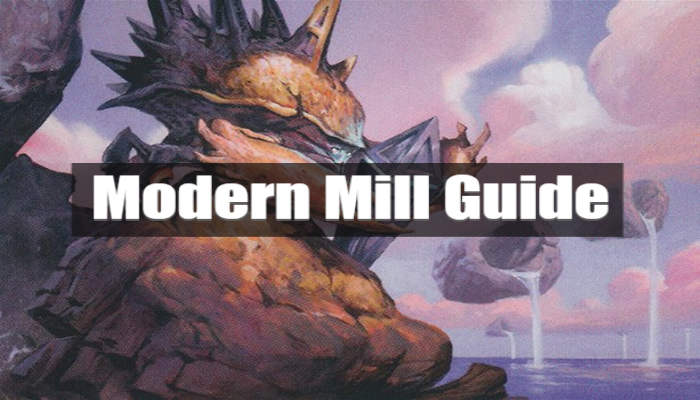The Modern Meta is very diverse and healthy at the moment. There’s a great variety of viable strategies seeing play with success and one of them is blue/black Mill. So, today I’ll be covering what the archetype is, how it plays, and which cards allow it to do what it does. Let’s start with a brief overview.
Mill decks are centered around the mechanic by the same name that makes a player put cards from the top of their library into the graveyard. If a player would draw a card while their library is empty they lose the game. So, “milling” the opponent’s deck away is the primary win condition for the strategy.
With that very basic idea out of the way, let’s go more in-depth and dive into the individual cards, how the deck plays in the beginning, middle, and end of a match, how to beat Mill if you come up against it, and which sideboard cards will help the most in the match up.
General Overview – How Does Modern Mill Work?
Instead of trying to get an opponent’s life from 20 to zero like most decks, Mill tries to get the opposing library from 60 cards to zero to win the game. The reason this works as a win-con is that if a player goes to draw a card and their library is empty, they lose the game. This may seem like a big task compared to damage-based strategies (after all, you’re tripling the number you need to achieve victory) but there are some pretty potent spells to help the strategy along.
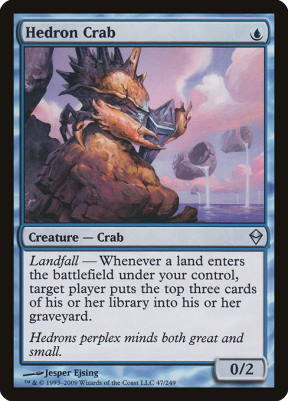
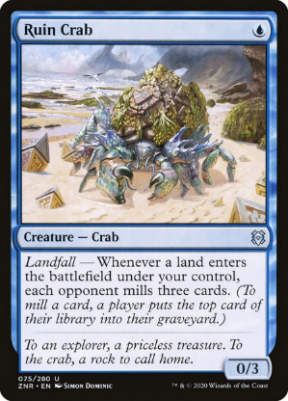
Creatures
Most decks play eight creatures – Four Hedron Crab and four Ruin Crab. Both represent a repeatable way to mill cards. Three cards may not seem like much but they’re especially effective alongside fetch lands such as Polluted Delta which can yield multiple triggers per turn. As an example, say there are two crabs in play, and you play a fetch land – Both will trigger and mill for six cards. Then, you use the fetch to search for another land and both will trigger when that one enters as well.
Assuming the deck continues to draw into lands to play, this adds up very quickly and doesn’t require spending any extra mana after the initial cost of the crab. That being said, any cards milled via crabs are usually in addition to whatever spells are actually being cast each turn.
Non-Creature Spells
With the exception of a few support cards, almost every spell in the deck is dedicated to milling cards. Here’s what you’re likely to see in a standard list nowadays.
Archive Trap
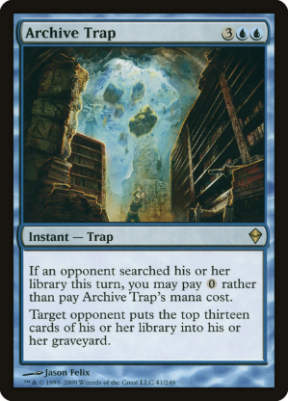
Archice Trap is a very important card for the deck. Its natural casting cost is five but you can cast it for free if an opponent searched their library the turn its cast. Many decks in Modern search for things of their own accord but Mill takes things a step further by playing Field of Ruin to destroy an opposing land and force them to search for another one.
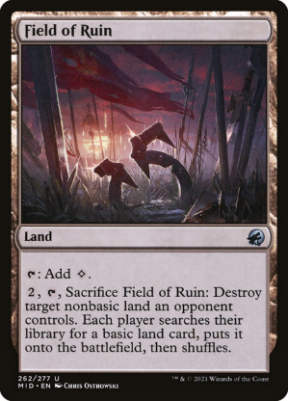
Not only does this remove their land from play and allow you to mill for 13 cards for free but it also allows you to search for a basic land too. So, you’ll trigger any crabs you have in play with this sequence too. What’s even better is when you have multiple copies that you can cast off of a single search. I’ve had opponents use fetch lands on their first turn of the game and I cast double Archive Trap and took out 26 cards before my first turn.
Tasha’s Hideous Laughter
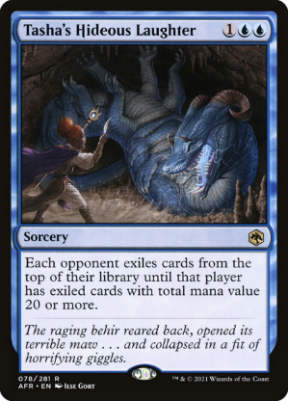
The lower the mana value of the cards in the opposing deck, the better this card gets and many decks in Modern have a very low curve. On average, Tasha’s Hideous Laughter mills around 19 cards, which is pretty amazing for a three-mana spell. After all, that’s over 1/3 of what you need to win if you consider the cards a player draws for their opening hand are no longer in the deck.
Just how many cards you’ll hit with this does depend on the deck you’re using it on of course. Perhaps the deck most affected by Tasha and her laughter is Hammer Time, which usually gets hit for around 35 cards! There are of course others (like Living End) that have high CMC cards which make it less effective. However, in general, this is a powerhouse card that puts the deck well on the way to victory.
It’s worth mentioning that there are both upsides and downsides to the fact that all the cards are exiled instead of going to the graveyard. The upside comes from the fact that the person being milled won’t have access to those cards. Again, this is relevant to decks built around Living End and anything else that benefits from having a full graveyard.
The downside comes from the fact that the mill player also plays cards (like Visions of Beyond) which care about the number of cards in the graveyard. The downside isn’t huge compared to the possibility of taking out half your opponent’s library in one fell swoop but I did want to mention it.
Fractured Sanity
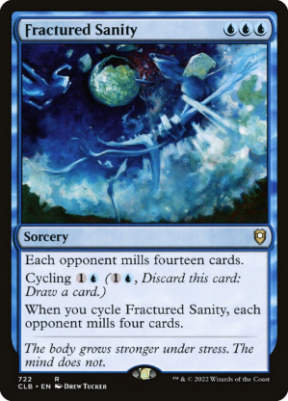
I like to think of this as the more consistent, more reliable older sibling of Tasha’s Hideous Laughter. You won’t get the massive numbers from this that you will from Tasha at its peak but you’ll never be stuck with an underwhelming cast either. For three mana, you’ll always get 14, and that’s very still good.
What’s even better is the fact that you can cycle this to draw another card and still get to mill a few cards. The consistency and versatility that this offers the deck are massive at times. There’s a bit of a learning curve to knowing when to cycle and when to cast this for full value. In my experience, it’s all about math and what you’ve got in your hand.
As a general rule, I stop and ask myself if milling the full 14 would put me in range of a victory with the resources I have on hand. If the answer is yes, I cast for three. If the answer is no, I cycle in hopes of finding whatever it is that will put me in range to win. This seems like a no-brainer but sometimes it’s not as intuitive as you’d think.
Support Cards
Aside from the cards that actually help secure the w from an offensive point of view there are quite a bit of cards that keep the boat afloat until then.
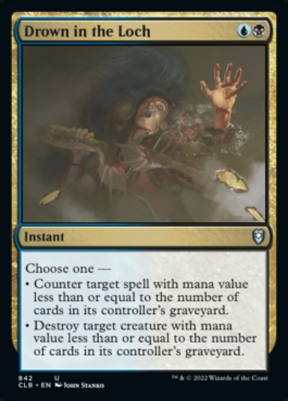
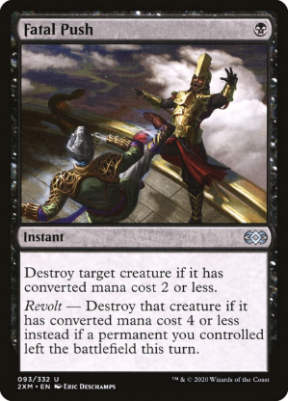
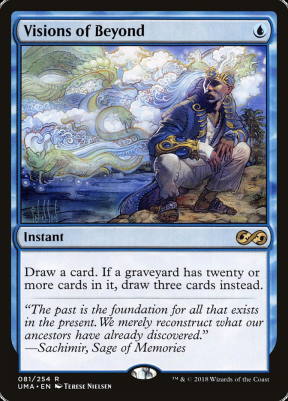
If you’ve noticed, Modern Mill has very little to put on
Fatal Push
If you’re in black Fatal Push is always a reliable way to answer early game plays like Ragavan, Nimble Pilferer, Dryad of the Illysian Grove, Monestary Swiftspear, and Puresteel Paladin. Given that Mill plays quite a few fetch lands to trigger the crabs, having revolt online isn’t a hard task.
Drown in the Loch
Drown in the Loch is the best piece of interaction that the deck has if you ask me. It’s a removal spell and a counterspell all wrapped up in one. Not only is this extremely versatile but it also scales depending on how many cards are in the opposing graveyard. Obviously, it’s problem for a devoted deck to have both portions of the spell up to a number too high for opponents to get around at any given time.
Visions of Beyond
Mill is the only deck in Modern getting to play Ancestral Recall. Well, not actually but that’s more or less what Visions of Beyond is for the deck. If things are going halfway decent for you, this will be a one-mana draw three and you can’t beat that. Even at its worst, it’s a cantrip that replaces itself and there are sometimes when that’s how you’ll use it.
There are a few times when you’ll have to play around your own cards with Visions though. Be sure to cast this before things like Extirpate ,Surgical Extraction, or Crypt Incursion when applicable so that you get the full value for it. That said, don’t play non-optimally to draw more cards. Some of the effects just mentioned are lifesavers, so don’t wait longer than you can afford to.
Surgical Extraction & Extirpate
Speaking of these cards, they’re quite common for Mill lists. You’ll usually see somewhere between two and a full four spread through the main deck and the sideboard. The thought for their inclusion is pretty simple – You’re loading the opposing graveyard with cards and being able to extract key pieces that you happen to mill over can be a backbreaker against decks who put all their eggs into a single basket.
Furthermore, effects like this are great ways to get around the “shuffle” effect of things like Emrakal, the Aeons Torn since you can Surgical it in response to the trigger and stop it from going back into the library.
Crypt Incursion
Remember when I said I had won more games because of Fraying Sanity than any other? Well, Crypt Incusion is a close second. As I mentioned, Mill can be vulnerable to aggressive strategies that can flood the
For three mana, you exile each creature from the opposing graveyard and gain three life for each one. By the time, you’re low enough on life to cast this, you’ve probably milled enough creatures to gain 30+ life. Which is usually more than enough of a cushion to mill out the remainder of their deck. Many decks play this in the sideboard (and that’s probably the best move) but I always put at least one in the main deck.
Jace, the Perfected Mind
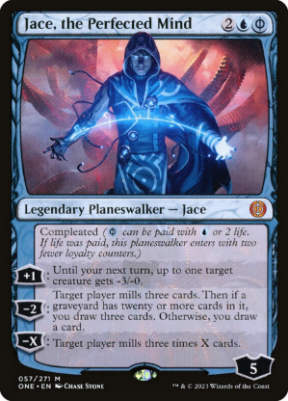
Here we have the newest addition to Modern Mill decks. And I must say, I misjudged it pretty badly – I thought that it wasn’t good and that it wouldn’t see play. I’m happy to inform you that I (and many others) were wrong. It’s very good and as a result, is seeing play.
I think what it boils down to is versatility. The -2 contributes to milling cards and functions as additional copies of Visions of Beyond. While the -x adds even more redundancy to the deck’s weapons. If you choose to cast this for three mana (and two life) you can mill nine cards with this. If you cast it for the full four mana, this will mill for 15.
All of this mill flexibility is stapled onto a permanent that can also draw cards, and can sometimes absorb damage from incoming attackers and you’ve got a recipe for success. I’ve been playing three copies in my deck and have been having great success with it.
Utility Lands
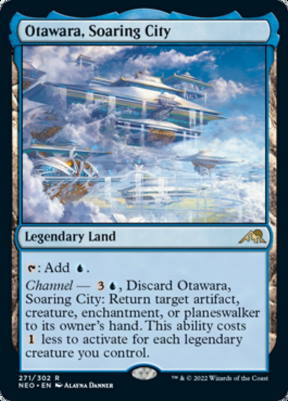
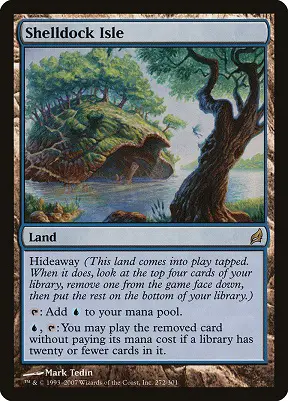
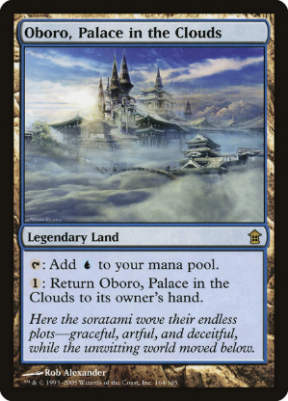
Aside from the fetch lands to help trigger crabs more often and Field of Ruin to enable Archive Trap there are a few other lands worth mentioning. First up is Otawara, Soaring City, which functions as an extra bounce/removal spell for the deck with no downside.
Next, is Oboro, Palace in the Clouds, which again, as a singleton inclusion, there is very little downside to including. The upside is that for one mana, you can return it to your hand and drop it again to trigger your Hedron Crab or Ruin Crab in a pinch.
Lastly, there’s Shelldock Isle, which has hideaway. Whenever you play it, you’ll tuck a card from your deck under it. Then lwhen a library has twenty or fewer cards in it, you can cast the card for free. Obviously, the stipulation is pretty easy for the deck to meet, and you can’t beat free cards.
The Ghosts Of Mill Decks Past
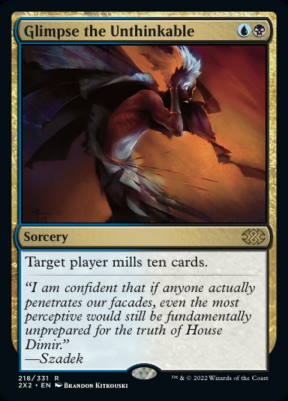
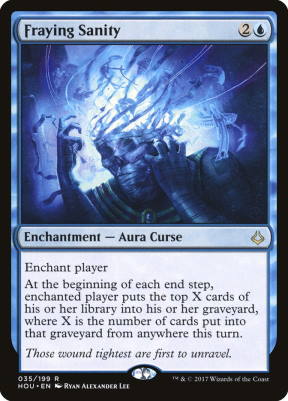
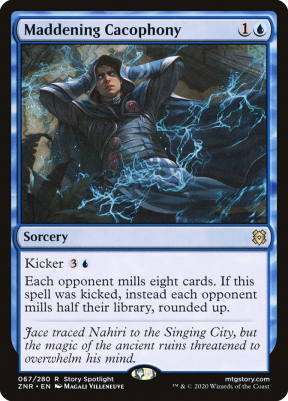
All the cards mentioned above, Hedron Crab, Ruin Crab, Fractured Sanity, Tasha’s Hideous Laughter, and Archive Trap make up the mill suite for current, competitive lists. However, this wasn’t always the case. Many of those cards are pretty new and before they came out, others were in their place.
Glimpse the Unthinkable
Glimpse the Unthinkable is a classic card for the deck and is my personal favorite mill card. That said, there are several factors that contribute to its obsolescence. First, two mana to mill 10 is a much worse rate than three mana mill 14 or three mana mill 30, in the case of Tasha’s Hideous Laughter.
Next, it targets the player you’re milling. This means that in the face of cards like Leyline of Santcity, Glimpse no longer works. Many of the newer spells say “each opponent” instead and are much better against cards that give hexproof. Lastly, is the casting cost. Without black and blue mana on turn two Glimpse wasn’t coming out on curve and it made otherwise good hands with solely blue mana awkward.
Maddening Cacophony
Maddening Cacophony is the card that initially took the place of Glimpse. After all, it doesn’t target and it doesn’t require black mana. Plus, the versatility of milling half the deck in the late game was worth the two cards you’re losing at face value. However, as more and more good mill pieces emerge from new sets it to has largely fallen out of Modern lists.
Fraying Sanity
This is another classic card that takes me back to when I first started playing Modern Mill. You enchant your opponent and then all your subsequent mill spells are twice as good because Fraying Sanity will see however many cards they’ve milled and mill that many at the end of turn. Furthermore, they stack!
As an example, say have two Fraying Sanity in play and you’ve milled an opponent for 13 cards. When you end your turn the first Fraying Sanity trigger will go on the stack and mill 13 more cards. Now comes the second trigger… Your opponent has now had 26 cards enter their graveyard for the turn. The second copy recognizes this and will mill them for 26 more. If I had to guess I’d say that I’ve won more games as a Mill pilot with this than any other card.
These were in the days before the three mana powerhouses mentioned above though. These days Tasha’s Hideous Laughter and Fractured Sanity are simply much more effective and there’s no real reason to run this in most builds. With so many powerful spells taking turn three off to play this isn’t where the deck wants to be anymore.
How Does The Deck Play – Early, Mid, And Late Game
Here is where I break down where the deck wants to be at different stages of the game. Mill isn’t exactly a linear strategy and many of your plays will depend on the
Early Game
Hedron Crab and/or Ruin Crab is always where you’ll want to be in the early game. Even more so if you have ample lands (hopefully fetches) and you’ll be well on your way to a victory. As I mentioned above, the triggers from this add up if the crabs survive and the mill they provide doesn’t cost you any mana beyond your initial investment to cast them.
It’s important to sequence your land drops on turn two if you have multiple crabs. For example, if you have a fetch land and a non-fetch land and at least one crab, start on the non-fetch land to cast your first crab. That way, if you top deck another one, you’ll get more triggers. Furthermore, play out every crab you have in hand before you drop your land for turn.
Mid-Game
This portion of the game will vary depending on the match-up. However, as a general rule, I would say you need to be milling. Regardless of how you started, you don’t want to durtle long without having your foot on the gas. Crabs are great out of the gate but they won’t often win you games without help.
In this portion of the game, cards like Fractured Sanity and Jace, the Perfected Mind are great to have since they contribute to the mill plan while also giving you access to other cards if that’s what you need. But can also offer more of a finishing blow as you move into the late game.
The mid-game is also where you’ll have to assess and deal with threats as they manifest. Is your opponent likely to have a threat that’s going to be hard to deal with if resolved? Well, you should probably hold up Drown in the Loch. If your opponent isn’t presenting much offense, you can probably lean into your own game plan.
One key card that you’ll want to be on the lookout for is Endurance as having an answer for it when it comes up can make or break you in this portion of the game.
Late Game
To me, there’s a lot of math involved in late-game choices. It’s not uncommon to be somewhat low on life and within a few spells of winning. Unless your victory just comes easily you’ll need to be asking yourself “How do I win? Which sequence of cards can mill these last x cards?” Once you start asking these questions you’ll start to formulate lines of play to get you across the finish line.
It’s also in this portion of the game where you’ll start cashing in on things like Shelldock Isle and full value Visions of Beyond. Overall, you’ll be assessing what you need to do to win and how it’s possible for you to lose.
How To Beat Mill
Here are some tips and tricks when going against Modern Mill decks.
- Remove Crabs Early – Hedron Crab and Ruin Crab may seem non-threatening but if left on
board can run away with the game quickly. - Be Aggressive – Mill doesn’t have much to offer in the way of blockers. So, establishing a
board presence early and keeping the pressure on can lead you to victory before you can be milled out. Having multiple threats to deal with makes a mill player’s job much harder and can force them to make less-than-optimal plays. - Use Your Life Total – Mill doesn’t care about your life total so neither should you – Don’t be afraid to use your life total in any way that helps you. Shock when you need to, cast both Thoughtsieze back to back, Dismember the turn one crab, etc.
- Play Around Archive Trap – Don’t get me wrong, you’ve got to do what you’ve got to do to run your deck. If you’ve got to use a fetch land or Summoner’s Pact to win, do it. But always keep Archive Trap in mind and don’t give any opportunities you don’t have to.
- Play Around Field of Ruin – If your deck needs very specific colors of mana at certain points in the game, keep that in mind early. Many players tend to forget that Mill plays 2-3 copies of Field of Ruin and if you’re not prepared to go down a land and have to fetch a basic, you could be cut off from an entire color.
How To Sideboard Against Mill
There are a few silver bullets for Mill but overall the deck is pretty steamlined in its game plan. Here are a few suggestions for what you should be doing post
What To Bring In
Shuffle Effects
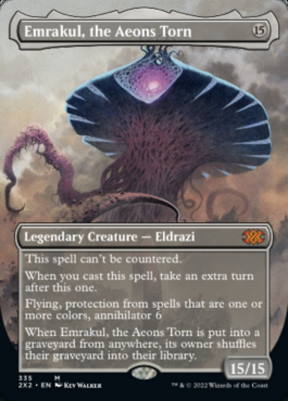
This refers to cards like Endurance and Eldrazi Titans like Emrakal, the Aeons Torn. Endurance is probably the best of these options but any that you have in your sideboard will do.
Counterspells
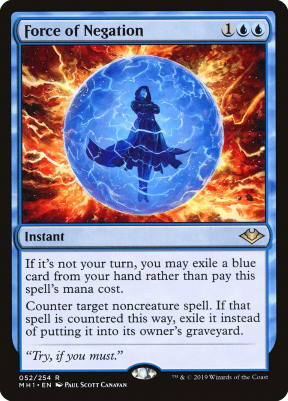
A lot of being a good Mill pilot is managing your resources well and playing to your outs. In my experience, many games come down to a few key spells/turns that determine which way the game will go. If your deck can support them, spells like Mystical Dispute, Spell Pierce, Counterspell, and Force of Negation can go a long way in negating those pivotal cards.
Removal
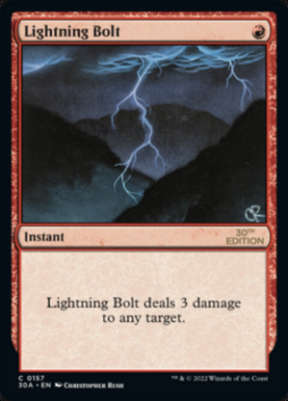
If you don’t play mainboard removal bringing some in for games two and three is a good idea. Answering early crabs can mean the difference between winning and losing. That said, I wouldn’t go out of my way to bring in Planeswalker removal for Jace, the Prefected Mind. As a Mill player, he generates value as soon as he enters and I am usually happy to see resources being devoted to him instead of elsewhere.
Deck List
U/B Mill
End Step
There you have it my friends, everything you need to know about Modern Mill – How it plays, the cards that enable it, and how you can beat it. Whether you’re a Mill player or someone reading as an opponent, I hope you found what you were looking for. Personally, this is one of my favorite decks to play and I enjoyed going over the ends and outs of it. Until next time, get out there and get some libraries to zero.
